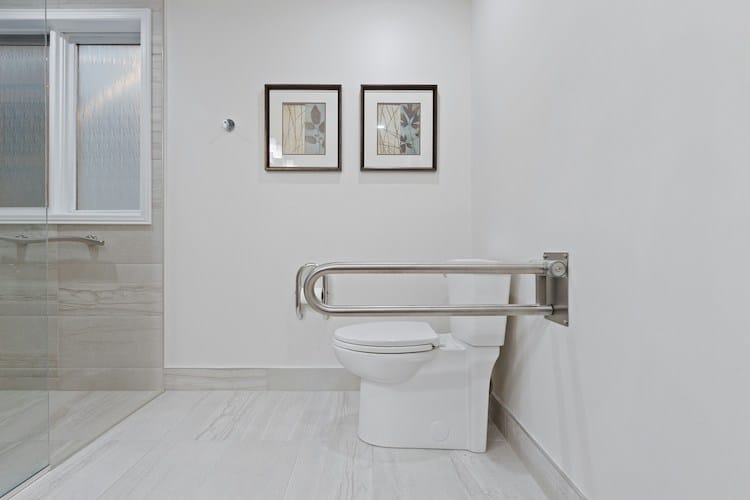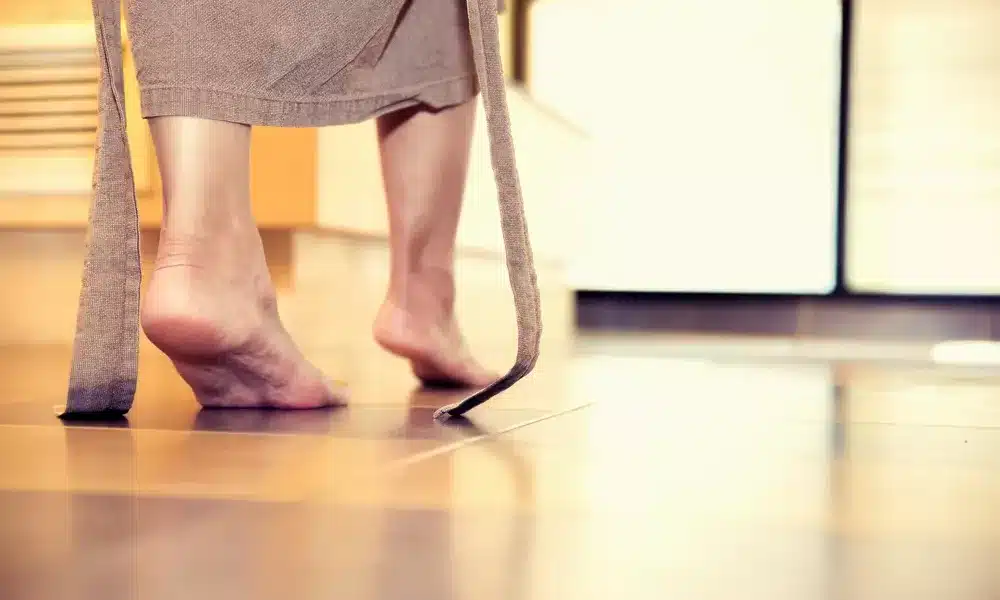The Three Best Non-slip Bathroom Flooring Options
Age Care Bathrooms can install your choice of non-slip bathroom flooring with minimal disruption. Contact our team of bathroom specialists to discuss your requirements and arrange a free home survey.
Non-slip flooring is essential to making the bathroom a safe and relaxing space. A slippery bathroom floor can cause serious injuries that might result from a fall, especially for older people. Non-slip flooring is, therefore, a feature of all the mobility bathrooms we install. Because anyone can slip, non-slip flooring not only reduces the chances of falling but also makes showering and having a soak in the bath easier and more enjoyable.
Disability can affect anyone at any age for many reasons, and when people get older, mobility may also be affected. Non-slip bathroom flooring for elderly people who are not experiencing mobility problems or dementia symptoms is also essential to prevent falls. According to the charity Age UK, bathrooms are where most accidents occur in the house.
At Age Care Bathrooms, we believe everyone should be able to shower or enjoy a bath independently without the fear of tripping, slipping, or falling. In this guide, you will discover the three best types of non-slip bathroom flooring and the key differences between them. If you require any more information, our friendly team of bathroom experts are happy to help. Simply call us or request a call back today.
Types Of Non-slip Bathroom Flooring for the Elderly and Disabled
Choosing the wrong flooring for mobility wet rooms or bathrooms can lead to dangerous, life-threatening accidents. Smooth-surfaced porcelain or ceramic tiles often become extremely slippery when wet, posing a significant hazard. Upgrading to non-slip bathroom flooring not only enhances safety but also adds aesthetic appeal without significant cost, mess, or hassle. Here are three excellent options for non-slip bathroom flooring:
Non-slip bathroom floor tiles
Designed with textured surfaces or special coatings, these tiles provide a safer alternative to traditional ceramic or porcelain tiles. They come in various styles and finishes, allowing you to maintain a stylish bathroom without compromising on safety.
Non-slip bathroom tiles must have a textured surface to be classed as non-slip. However, the level of slip resistance can be different depending on the material used for anti-slip tiles.
- Ceramic and porcelain tiles. An R rating is assigned by the Porcelain Enamel Institute (PEI) to both ceramic and porcelain anti-slip tiles. The R rating number is between one and five; the higher the number, the greater the non-slip surface. Non-slip bathroom tiles with a minimum safety grade of four should be used for flooring in wet rooms and bathrooms.
- Stone tiles. Typically, stone tiles such as limestone or tumbled marble have a naturally rough or textured surface, making them non-slip. However, as they are porous, they will need to be sealed when used in a bathroom. It’s essential to check that anti-slip sealant is used, or once sealed, these tiles could become slippery when wet.
Bathroom rubber flooring
This option offers excellent traction, even when wet, making it ideal for wet rooms and bathrooms used by individuals with mobility challenges. Sheet rubber flooring is generally a less popular option as it is more expensive than vinyl flooring.
When cost is not a concern, rubber flooring is durable, easy to clean, and available in various colours and patterns to match your bathroom decor.
Other benefits of rubber flooring are:
- Eco-friendly recycled rubber flooring is available.
- Highly durable and resists dents and stains
- Naturally antimicrobial to prevent mould growth
- Provides a high level of shock absorbency, reducing the potential for injury if a fall does occur.
Non-slip vinyl flooring
A cost-effective and versatile choice, sheet non-slip vinyl flooring provides a textured surface that enhances grip. It’s waterproof and comes in numerous designs, mimicking the look of wood, stone, or traditional tiles while ensuring a safer bathroom environment.
Non-slip vinyl tiles and plank flooring are less durable than ceramic, porcelain and stone tiles and are classed as water-resistant rather than waterproof. Yet, vinyl tiles offer a higher slip resistance and provide one of the best types of bathroom flooring for elderly or disabled users. However, this type of flooring is best avoided in wet rooms as it is not completely waterproof.
Additional benefits of sheet vinyl flooring include:
- Less expensive than ceramic, porcelain or stone tiles
- Easy to clean
- Low maintenance
- It can be cushioned to offer an excellent level of shock absorption, lowering the risk of injuries if an accident does happen.
Bathroom Safety Aids
Choosing the best non-slip bathroom flooring for elderly and disabled users can certainly make the bathroom safer, but safety aids are still essential to reduce the risk of slipping or falling.
You may also want to install some or all of the below mobility aids:
- Grab bars
- Support poles
- Shower seat or stool
- Bath seat
- Raised toilet seat.
If you’re updating your bathroom flooring, it’s an ideal time to consider additional upgrades for enhanced accessibility and convenience. This is the perfect opportunity to install features such as:
- Disabled toilet: Designed with accessibility in mind, disabled toilets provide features such as a higher seat, handrails, and more space around the unit. These adaptations make it easier for people with mobility issues to use the toilet independently and safely.
- Walk-in baths offer a safe and comfortable bathing experience for those who find getting in and out of traditional baths challenging. With a watertight door for easy entry and exit, built-in seating, and grab bars, walk-in baths eliminate the need to step over high tub walls, reducing the risk of slips and falls and allowing wheelchair users to have independent access to the bath.
- Walk-in showers are designed for easy access, often featuring a low or no-threshold entry. They typically include slip-resistant flooring, built-in seating, and strategically placed grab bars. These features make walk-in showers an excellent choice for anyone looking to improve safety and wheelchair accessibility in their bathroom.

Essential Considerations When Choosing Non-slip Bathroom Flooring
Selecting the right flooring for your bathroom is crucial for safety and style. Here are the key factors we recommend considering to ensure you make the best choice:
- Durability: It’s important to ask about the estimated lifespan of your flooring and if it comes with any warranty to cover the cost of replacement if it is damaged. Here is a general guide to the durability of different types of non-slip bathroom flooring:
- Non-slip bathroom tiles: provided they are sealed and maintained, they can last 100 years or more.
- Non-slip bathroom vinyl tiles and plank flooring have a lifespan of 15 to 20 years; however, this is based on their resistance to wear. When used in a wet room, they may not last as long due to water damage.
- Non-slip bathroom vinyl sheet flooring can last 10 to 20 years, depending on how thick it is, since this significantly impacts its lifespan.
- Non-slip bathroom rubber flooring: More durable than vinyl flooring and less likely to tear or crack, bathroom rubber flooring has a lifespan of around 20 to 30 years for commercial use and can last much longer in a residential property.
- Maintenance: When choosing bathroom flooring, it’s essential to consider maintenance requirements and affordability. Here’s a general guide to the maintenance needs of various types of non-slip bathroom flooring:
- Vinyl and Rubber Flooring: These materials are low-maintenance and require only regular cleaning to stay in good condition. They don’t need sealing or special treatments.
- Tiled Floors: The grout in tiled floors (excluding vinyl tiles) needs regular maintenance. Grout is porous and can retain water, leading to bacteria and mould growth. For tiled wet room flooring, grout should be resealed every year or two to maintain hygiene. Additionally, stone and marble tiles typically require resealing every two to five years to protect against water damage and stains.
- Slip resistance certification: Look for flooring materials certified for slip resistance. This certification ensures the product meets safety standards and provides peace of mind, especially in wet environments.
- Danger of injuries: Porcelain, ceramic and stone tiles are hard, so there is a greater possibility of sustaining a severe injury in the event of a fall. In contrast, anti-slip vinyl and rubber flooring can incorporate an underlayer that is “cushioned” to lessen the impact if you fall, reducing the potential harm to your joints and bones.
- Repair and replacement: Consider the repairability of the flooring. Anti-slip tiles can be replaced individually if damaged, making them a practical choice for long-term use. In contrast, sheet vinyl or rubber flooring can be challenging to repair if ripped or punctured. This can be a significant factor if you plan to replace or move fixtures like showers or baths in the future.
- Underfloor heating: In colder climates, consider flooring options compatible with underfloor heating systems to keep your bathroom cosy. Underfloor heating is generally easier to install with vinyl or rubber flooring options, which have excellent thermal insulation.
- Cost and installation: Some flooring types are easier and quicker to install than others. Compared to anti-slip vinyl flooring, porcelain, ceramic, and stone tiles are typically more expensive and require more installation time. Consider whether you will need professional installation and how long it will take.
Do You Need Help to Find the Best Non-slip Bathroom Flooring?
If you need guidance on selecting the best flooring for your wet room or mobility bathroom, our team of bathroom experts is here to assist you. We offer personalised advice to help you choose the perfect flooring that combines safety, functionality, and aesthetic appeal. Whether you’re looking for non-slip tiles, rubber flooring, or any other type of bathroom flooring, our knowledgeable professionals can provide recommendations based on your specific needs and preferences.
Don’t hesitate to call or complete our online form for expert advice about mobility bathrooms and non-slip flooring, our team of bathroom experts are happy to help.












